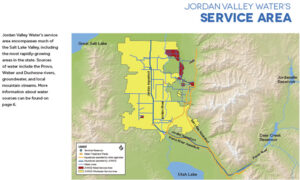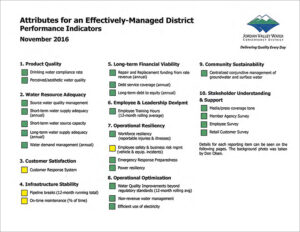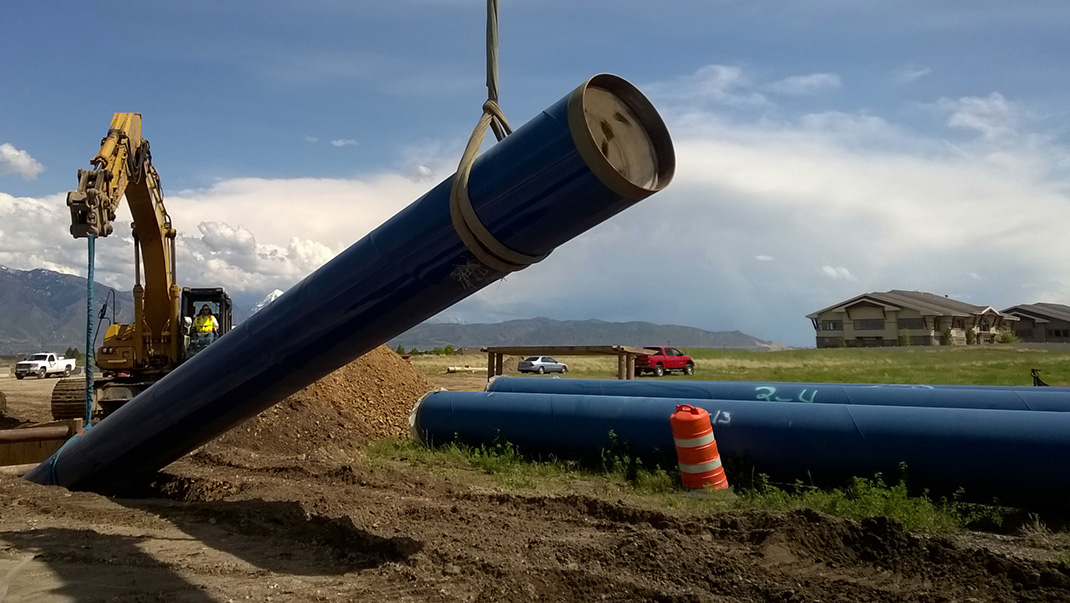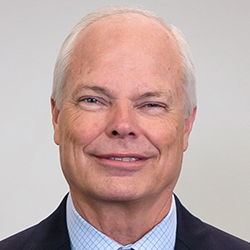One of Utah’s largest water districts, Jordan Valley Water Conservancy District, is responsible for providing a sustainable water future to a number of the fastest-growing cities in the country. Brown and Caldwell Vice President Jeff Theerman recently sat down with General Manager Richard Bay to talk about how JVWCD is embracing continuous improvement, utility performance goals and new technology to fulfill this responsibility.
Richard describes how Jordan Valley uses an Effective Utility Management report card and principles to align the organization with strategies that address the big challenges to a sustainable water future.
Jeff: How did you first get interested in water?
Richard: My father is a civil/hydrologic engineer who was assigned to the Philippine Islands to assist in the planning and predesign of some water projects, so our whole family moved to Manila when I was 12. I went on field trips with him as he conducted this work and at that young age I decided it was really important stuff. That interest carried on through my university studies and then into my profession.
Jeff: The district recognizes that water conservation, sound planning, and infrastructure maintenance are vital to a sustainable water future. Tell us about this vision and how are you working toward it.
Richard: One of the unique aspects of our service area is fast population growth. We have some of the country’s fastest-growing cities in our service area. Our population is projected to double by the year 2060. Our member cities expect that we will not only keep up with a growing water supply, but stay ahead of the curve with their population growth. They rely on us heavily to do that.
So the challenge to maintain a clean, sustainable water supply for today’s demands is large, but equally large is planning for the future and developing water supplies fast enough to stay ahead of the curve. Because of this, we’ve realized that efficient use of water is critical, and that is the first effort we have to pursue.

That is made interesting and challenging because throughout Utah there is a strong tradition of beautiful communities and landscaping. Almost two-thirds of the water we deliver is used outdoors for landscaping, and so we had to figure out how to become more water wise through conservation programs without sacrificing the appearance of our communities. This is so important to our customers and our member city leaders. We’ve pursued water conservation programs with an emphasis on outdoor water, since that’s where the biggest opportunity is and that’s where the biggest inefficiencies are. We have found ways and have some great programs that can show any homeowner how to use half the water outdoors that they had been using and still have a beautiful, lush landscape that meets the traditional expectations.
The next effort — really a parallel effort — is developing new water supplies. About 70 years ago, we reached the maximum yield of all of the water supplies that originate in Salt Lake Valley, so as we develop future supplies we’re extending farther and farther into distant river basins. For example, our most recent projects are capturing water 40, 50, and 60 miles away and we’re building large infrastructure to convey that water to our service area. At the same time, we are adding this infrastructure to our inventory, and we are balancing that with efforts to care for and renew our aging infrastructure to maintain the level of service that is increasingly important to our public.
Jeff: The things you’ve talked about — long distances for supply, relying on some means of conservation, the maintenance of facilities, getting the most out of their life — that presents certain planning ramifications involving a lot of stakeholders. How are you tackling that difficult planning horizon, if you will, because it seems like it’s key to me.
Richard: We realize that these new water supplies take decades to negotiate, develop and finance. We also feel strongly the expectations of our member cities to stay ahead of the curve and never fall behind. Recently, the development director of one of our member agencies that undertook a strategic planning process said to me that they appreciate our long-term planning and advance development of water. He said if there’s even a hint that we may fall behind they would not be able to attract the industries and the large commercial establishments they want to attract to create the kind of community they want. There’s an economic damage or harm if there’s even a rumor.
So because of that we have adopted an active 50-year planning horizon. That then brings another challenge, which is financing the capital costs of projects well ahead of when the first user is taking water. We have worked with our board of trustees and with the state Legislature for creative ways to finance those projects. A solution that we’ve advocated is that there be a partnering between water conservancy districts and other water agencies in sharing a large part of the burden. Some of the financing then would be done by cities, improvement districts and metropolitan water districts. We’ve advocated to the state that it has a new role to help finance the infrastructure of our interstate river allocations in the Colorado River on the south and the Bear River in the north.
We have also shared with our member cities and with the Legislature the water conservancy district success story. It is a unique experiment in Utah and in part it’s successful because the board of trustees that govern are one step removed from the immediate political urgencies — they are nominated by cities and appointed by the governor. That allows our board and our staff to work together on a 50-year horizon, whereas if they were elected to the board, their planning horizon may shrink to five years or less. That would impair our ability to accomplish long-term planning.
Another success story of the district “experiment” is that Jordan Valley and the other three largest water conservancy districts in the state recently collaborated to develop a statewide water infrastructure plan. This plan and the organization formed to promote it are called Prepare 60. Prepare60 was well received by the Legislature as its guiding document to feel that as a state we have a direction and we have a firm plan.

Jeff: What are some of the other challenges to achieving a sustainable water future?
Richard: It used to be that we did such a great job providing water that nobody knew we existed and the public assumed that water just magically appears at the tap, but that is changing. One of our challenges is to provide enough education and public information so that there’s an appreciation for where water comes from and the difficulties of developing it. This extends to elected officials. We’re trying to develop new ways to communicate better, to communicate more often and to communicate more persuasively, so that elected officials have a basic knowledge of what direction we’re going and what needs to be done and they feel an obligation to be part of the team to make it happen.
The next challenge is the high up-front capital cost of water infrastructure and finding better ways to finance that so that it can then go into repayment by water users. In Utah, we’ve always been a “user-pay” state, where water users repay all the costs of water. That can be difficult because our water infrastructure projects are intended to span generations of people and not just the next one or two decades. We are trying to accomplish some generational equity in having future generations/customers help to share the repayment burden. With the federal willingness to finance water projects in Utah drying up, we’re finding ways to partner with the state for long-term financing and finding ways to spread the cost over longer periods of repayment, so that the first and the second generations of water users can all help repay the debt.
Jeff: You’re talking well beyond the term of normal bonds. You hear a few creative things out there like century bonds but that’s fairly rare, right?
Richard: Yes. The practicality of debt service for repayment terms beyond 30 years is pretty low. But the Deer Creek Dam and Reservoir, for example, have been a mainstay in serving our public for the last 70 years and we just made the last payment a year ago. So there’s three, and almost four, generations of people who benefitted from that project and the ability to extend that repayment over 70 years was a blessing to our public. It’s going to be more difficult as the repayment terms shrink to 30 years, but it’s probably as realistic as we can be.
Jeff: We’ve talked about the district’s strategies to address the high-level challenges that we face as water service providers. How do you align staff from the entire organization to facilitate the implementation of those strategies to ultimately provide quality water and services every day?
Richard: Ten years ago, we realized a problem in our district, which I believe is shared by most water or wastewater agencies, and that is a lack of morale. What we found is that our staff who were operating and maintaining our system were doing a good job day by day, but they didn’t know what role that had in the mission or direction of the district. And they didn’t know how to measure the effectiveness of what they were doing. They just did the same thing day after day. They didn’t even have a strong feel for what their role was in our overall district team.
So we realized there was a need for building a consciousness of why their work is important and how it fits in with the major direction or objectives of the district. At the same

time, we were searching for a way to better communicate our progress to our board of trustees. The concept of Effective Utility Management was in its infancy at the time and it seemed to be the right framework to deal with the challenges that we were experiencing at that time.
So we assembled a broad staff strategic planning committee drawn from every group, from line worker to highest manager. The objective of the committee was to first redefine our mission, our vision, and our top values. Then, we developed a strategic plan based on our mission, vision and values statements. Lastly, we used the Effective Utility Management framework to develop performance indicators to help us track our progress to immediately know when we start falling short in any area.
Just convening this strategic planning committee among our staff was a morale builder. We talked about the fact that in the water industry, the standards we’re expected to meet are higher than in any other industry I know. In the water industry, we have to deliver a commodity every day, every hour, every minute and if we stop doing it, there becomes a crisis. Not only that, we’re expected to comply with standards 100 percent of the time. There’s no tolerance for non-compliance. So that’s a pretty high standard and we developed a sense of pride that we were meeting those ultra-high standards.
We developed a brief mission statement and a brief vision statement, talking about our growing population, the need to develop water sources that are sustainable for the long term, and that the Utah Water Conservancy Act says a water conservancy district exists to provide for the welfare, prosperity and economic growth of communities. We then named our top five values. Our top value was safety: internal safety for our workers and external safety for our customers.
Then we started on our strategic plan and we developed it from the 10 Attributes for an Effectively Managed Utility. And there was a healthy discussion about why that is important. How does that relate to our district? Why does the public expect that attribute? For each of the 10 attributes, we developed a strategy, how to accomplish that as it uniquely is needed in our service area and in our state. And we identified five or six major strategies that would accomplish our objective in each attribute.
Then we were ready to create a way of tracking how we were doing to facilitate continuous improvement. For each of the 10 Attributes for an Effectively Managed Utility, we identified the performance standards and a target of where we wanted to be for excellent performance. There’s initially a desire to develop performance standards in every aspect of each of the 10 attributes and we quickly found that we were getting overwhelmed with too many indicators. So we stepped back and said, “OK, we’re going to select the top three, or four at most, indicators that are most important in capturing the essence of that attribute.” We then identified a range below that target range to tell us when we’re getting out of our desired target range. And then finally we identified a range below that to indicate that urgent attention is needed.
 Having defined the performance indicators, we then developed a means for reporting measured performance to different audiences. For our board of trustees, we developed a one-page “report card” that is the at-a-glance indicator. We color-coded each of the indicators — green when we’re in our target range, yellow when we’re just getting out of range and red when we’re way out of range. It creates an interesting dynamic. Initially, I explained to the board that if they ever see all of these indicators green, “then you know that we’re either lying or we didn’t set our targets aggressively enough.” They asked that we review one performance indicator each month during a work session, and those discussions were quite helpful. They gained a comfort level with each and now they look forward to reviewing the performance indicators report each month.
Having defined the performance indicators, we then developed a means for reporting measured performance to different audiences. For our board of trustees, we developed a one-page “report card” that is the at-a-glance indicator. We color-coded each of the indicators — green when we’re in our target range, yellow when we’re just getting out of range and red when we’re way out of range. It creates an interesting dynamic. Initially, I explained to the board that if they ever see all of these indicators green, “then you know that we’re either lying or we didn’t set our targets aggressively enough.” They asked that we review one performance indicator each month during a work session, and those discussions were quite helpful. They gained a comfort level with each and now they look forward to reviewing the performance indicators report each month.
For managers, we supplement the at-a-glance report card with a dashboard providing a little more data behind each indicator. One of the values of this approach for us as managers is that it immediately puts our attention to where we’re getting out-of-target range and so we’re almost in a real-time basis for continuous improvement. When we see an indicator that turns red, then it’s “all hands on deck” to get that one back within range.
Finally, we found that it was important to communicate to all of our employees, down to the line employee, so that every employee can look to at least one performance indicator that they are contributing to. This allows them to track if they’re accomplishing what they or their team needs to do to keep in target range.
It’s been a morale builder among our staff because everyone knows why they’re doing the job they’re doing. Metaphorically speaking, it has helped everyone see that they’re not “laying bricks, they are building a cathedral.” The maintenance worker who used to feel he/she just came to work and did the same thing day after day, now has some performance indicators. They know that the team has objectives and can see the measurement every day, every week, every month, to know if they are accomplishing them. And it gives a lot of pride and sense of teamwork to our employees to be part of that.

